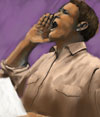March 18, 2009

Media Fogging the Card Check Debate
Marc Comtois
Mickey Kaus has been on top of "card check" from the get go. His latest takes on some of the media spin regarding the issue:
The labor side's ability to get reporters to use their version of card-check's controversial secret ballot provisions continues to amaze. Here's WaPo's Alec MacGillis:Kaus also points to this recent Rasmussen poll:The bill, first introduced in 2003, gives workers the choice of whether they want to organize by getting a majority of workers to sign pro-union cards, instead of having to hold secret-ballot elections.That's one finely-spun sentence there. Who are the "workers" who will have this "choice"? They are the union organizers mounting a unionization campaign. Do any other "workers" who sign or don't sign the cards have a "choice" of methods? a) The cards aren't to choose the method. They are to choose the union. If 50% of the workers sign the cards the union will have won, period. An election at that point is prohibited; b) The only way an individual worker could use this system to "choose" a secret ballot election is by somehow signing a card if it will help union organizers meet the 30% threshhold required for an election but refusing to sign it if it will give the union organizers the 50% that will kill the election. House Majority Leader Steny Hoyer recently outlined this complicated card-signing strategy with a straight face on the House floor. But of course no individual worker will know if his signed card will provide the 31% plurality or the 51% majority. Only the organizers know this. You could sign the card intending to provoke an election and discover that you actually prevented an election. There's no way for ordinary workers to reliably game the system in order to "choose" a secret ballot. c) The whole underlying dispute is over whether the act of signing cards is an accurate expression of worker choices, or whether it subjects individuals to subtle and unsubtle community pressure to vote against their real preference. By assuming that the cards represent the true "choice" of workers, Hoyer and others assume what is at issue.
National Survey of 1,000 Adults
Conducted March 13-14, 2009By Rasmussen Reports
1* Do most working Americans want to belong to a Labor Union?
23% Yes
44% No
33% Not sure2* [Answered Only By Those who are Non-Union Members] Would you like to belong to a labor union where you work?
9% Yes
81% No
9% Not sureNOTE: Margin of Sampling Error, +/- 3 percentage points with a 95% level of confidence
9:00 AM
| TrackBack (0)



 About Community Crier
About Community Crier

 About Engaged Citizen
About Engaged Citizen Administrator
Administrator




It’s all about money and power - the unions lie and dissemble regarding EFCA. It’s not about worker choice or building the middle class or any of their other spin - it’s about getting millions more “dues units.” Note this Congressional testimony from a former union organizer:
“In most cases, the workers have no idea that there is a union campaign underway. Organizers are taught to play upon this element of surprise to get “into the door.” They are trained to perform a five part house call strategy that includes: Introductions, Listening, Agitation, Union Solution, and Commitment. The goal of the organizer is to quickly establish a trust relationship with the worker, move from talking about what their job entails to what they would like to change about their job, agitate them by insisting that management won’t fix their workplace problems without a union and finally convincing the worker to sign a card."
"At the time, I personally took great pride in the fact that I could always get the worker to sign the card if I could get inside their home. Typically, if a worker signed a card, it had nothing to do with whether a worker was satisfied with the job or felt they were treated fairly by his or her boss. I found that most often it was the skill of the organizer to create issues from information the organizer had extracted from the worker during the “probe” stage of the house call that determined whether the worker signed the card. I began to realize that the number of cards that were signed had less to do with support for the union and more to do with the effectiveness of the organizer speaking to the workers”
“I began my career with UNITE with a strong belief in worker’s rights and democracy in the workplace. During the course of my employment with the union, I began to understand the reality behind the rhetoric. I took in the ways that organizers were manipulating workers just to get a majority on “the cards” and the various strategies that they employed. I began to appreciate that promises made by organizers at a worker’s house had little to do with how the union actually functions as a “service” organization."
"For example, we rarely showed workers what an actual union contract looked like because we knew that it wouldn’t necessarily reflect what a worker would want to see. We were trained to avoid topics such as dues increases, strike histories, etc. and to constantly move the worker back to what the organizer identified as his or her “issues”
during the first part of the housecall. This technique was commonly referred to as “re-agitation” during organizer training sessions. The logic follows that if you can keep workers agitated and direct that anger at their boss, you can get them to sign the card.”
Or even better, check out (no pun intended) these excerpts from an NLRB consent agreement executed by Pat Crowley’s union organizing alma mater “da Teamstuh’s union.” It seems hard to believe that people such as this would coerce non-union workers into signing authorization cards, now doesn’t it?:
“WE WILL NOT brandish or carry any weapon of any kind, including, but not limited to, guns, knives, slingshots, rocks, ball bearings, liquid-filled balloons or other projectiles, sledge hammers, bricks, sticks, or two by fours at or near any picket line, handbilling effort, rally or in any vehicle engaged in mbulatory picketing of any Overnite vehicle or following the private vehicle of any Overnite employee.”
“WE WILL NOT endanger or impede the progress of or harass any non-striking employee or any employee of a neutral person doing business with Overnite, while he or she is operating a company vehicle or his or her own personal vehicle, by jumping on vehicles, by attempting to open the doors of vehicles, by throwing paint on windshields, by using mirrors, laser pointers, spot lights or flash photography in the eyes of drivers, or by obstructing the view of drivers by holding picket signs over the windshields of vehicles. “
“WE WILL NOT threaten to kill or inflict bodily harm, make throat slashing motions, make gun pointing motions, challenge or threaten to fight or assault employees, threaten to sexually assault non-striking employees or their family members, threaten to follow non-striking employees to their homes, use racial epithets or obscene gestures at non-striking employees or otherwise threaten unspecified reprisals on any non-striking employee of Overnite or any member of his or her family or any employee of a neutral employee doing business with Overnite, or on any security guard, supervisor or manager of Overnite or neutral employers doing business with Overnite in the presence of employees.”
Posted by: Tom W at March 18, 2009 1:31 PM